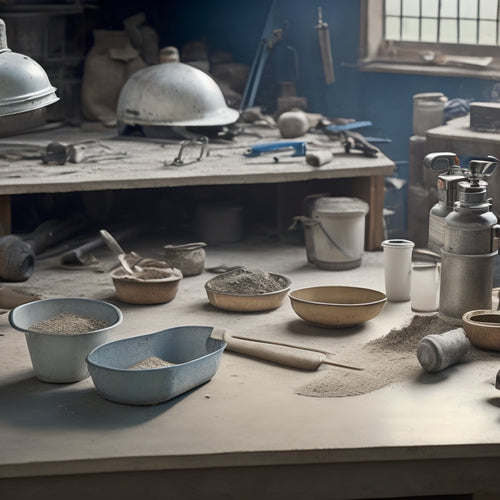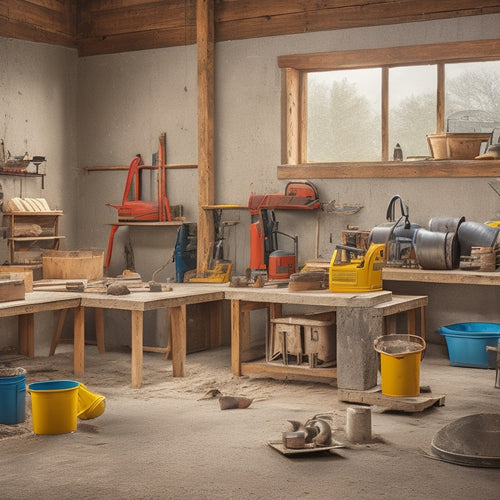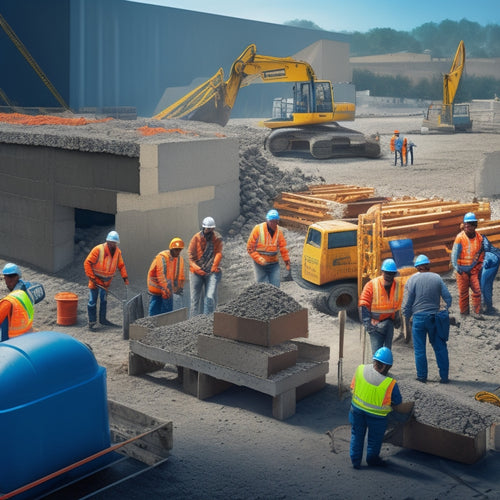
7 Best Tools for Laying Concrete Fence Foundations
Share
When laying concrete fence foundations, you'll need a range of specialized tools to guarantee a strong and durable base. Start with measuring and marking tools like laser levels, transit levels, and chalk reels to verify ground levelness and snap lines for visual guides. Next, use mixing and pouring equipment like concrete mixers, pouring buckets, and vibration rods to guarantee consistent mixing and compact pouring. Don't forget tamping and compacting machines, leveling and aligning devices, concrete finishing hand tools, safety gear, and cleanup essentials to complete the job. With the right tools, you'll be well on your way to a flawless foundation - and there's more to explore to get it just right.
Key Takeaways
• Accurate measuring tools like laser levels, transit levels, and measuring tapes ensure correct foundation layout and calculation of concrete quantity.
• A concrete mixer is essential for consistent mixing, and a pouring bucket with a smooth interior enables efficient concrete transfer.
• Tamping machines and soil testing equipment help control soil density and identify optimal moisture content for compaction, ensuring a stable foundation.
• Leveling and aligning devices like laser levels, alignment stakes, and digital levels guarantee structural stability and precise foundation alignment.
• Concrete finishing hand tools, including tamping tools, edgers, floats, trowels, and brooms, are necessary for a smooth and textured finish.
Measuring and Marking Tools
You'll need a set of accurate measuring and marking tools to confirm your concrete fence foundation is laid out correctly. This is vital, as even the slightest miscalculation can lead to a weak foundation, compromising the entire structure.
To achieve precision, employ advanced measuring techniques such as using a laser level to verify the ground is level and a transit level to check the accuracy of your measurements.
For marking strategies, utilize a chalk reel to snap lines, creating a clear visual guide for your excavation and concrete pouring. Additionally, a measuring tape and calculator will come in handy for calculating the exact concrete quantity required.
Don't forget a set of string lines and stakes to define the boundary of your foundation.
Mixing and Pouring Equipment
With a precise layout in place, six vital mixing and pouring equipment pieces take center stage to transform raw concrete into a strong, durable foundation.
You'll need the right tools to achieve ideal mixing techniques and pouring methods. Here are the must-haves:
-
Concrete Mixer: A robust mixer that can handle large batches of concrete, guaranteeing consistent mixing and minimizing the risk of segregation.
-
Pouring Bucket: A sturdy, heavy-duty bucket designed for efficient pouring, with a smooth, rounded interior to prevent concrete from sticking.
-
Vibration Rod: A versatile tool that helps eliminate air pockets and guarantees a compact, even pour.
- Pouring Chute: A precision-engineered chute that directs the concrete flow, reducing spillage and mess.
With these tools in your arsenal, you'll be able to achieve a flawless pour, every time.
Tamping and Compacting Machines
When you're working with tamping and compacting machines, you'll need to guarantee you're getting the right density control for your soil.
This means adjusting your compaction depth settings to match the specific requirements of your project.
Soil Density Control
Before pouring concrete for your fence foundation, make certain the soil is compacted to the perfect density using tamping and compacting machines, which help prevent settling and cracking. You'll want to make sure the soil is stable and can support the weight of your fence.
To achieve ideal soil density, you'll need to:
-
Conduct soil testing to determine the soil type, its bearing capacity, and any potential settlement issues.
-
Perform moisture analysis to identify the perfect moisture content for compaction, as excess moisture can lead to weak concrete.
-
Select the right tamping and compacting machines for your specific soil type and project requirements.
- Monitor and adjust the compaction process to make sure the soil reaches the desired density, taking into account factors like soil moisture and temperature.
Compaction Depth Settings
You need to set the compaction depth on your tamping and compacting machines to guarantee the soil is compacted to the required density, taking into account the soil type, moisture content, and project specifications. This guarantees the soil can withstand the weight of the concrete fence foundation and prevents settlement or instability issues.
To achieve ideal compaction, you'll need to adjust the compaction depth based on the soil's moisture content. For instance, if the soil is too dry, you may need to set the compaction depth shallower to avoid over-compacting, which can lead to soil degradation. Conversely, if the soil is too wet, you may need to set the compaction depth deeper to guarantee adequate compaction.
When selecting compaction techniques, consider the soil type and project requirements. For example, vibratory compactors are effective for granular soils, while static compactors are better suited for cohesive soils.
Leveling and Aligning Devices
Precise leveling and aligning devices are essential for guaranteeing that concrete fence foundations are laid accurately and securely, as even slight deviations can lead to structural instability.
You can't afford to compromise on the accuracy of your foundation, as it's the backbone of your entire fence. To achieve perfection, you'll need the right tools for the job.
Here are the top leveling and aligning devices you should consider:
-
Laser Levels: These devices project a level line or plane, allowing you to guarantee your foundation is perfectly horizontal or vertical.
-
Alignment Stakes: These stakes are used to mark the position of your fence posts, guaranteeing they're perfectly aligned and spaced.
-
Optical Levels: These devices use a telescopic lens to provide a precise reading of your foundation's levelness.
- Digital Levels: These electronic devices provide precise digital readings, making it easy to detect even the slightest deviations from perfect levelness.
Concrete Finishing Hand Tools
With your concrete fence foundations accurately leveled and aligned, it's time to focus on achieving a smooth, even finish using the right concrete finishing hand tools. You'll need a combination of specialized tools to achieve the desired finish, whether it's smooth, textured, or stamped.
Here are some essential concrete finishing hand tools you'll need in your arsenal:
| Tool | Description | Finishing Technique |
|---|---|---|
| Tamping Tool | Used to compact and flatten concrete | Smooth Finish |
| Edger | Creates a clean edge along the foundation | Textured Finish |
| Float | Evens out the concrete surface | Smooth Finish |
| Trowel | Applies pressure to compact and smooth the surface | Stamped Finish |
| Broom | Creates a textured finish by dragging the bristles across the surface | Textured Finish |
Regular tool maintenance is vital to guarantee peak performance and extend the lifespan of your tools. Clean and store them properly after each use, and perform regular inspections for damage or wear. By mastering the right finishing techniques and maintaining your tools, you'll be able to achieve a professional-looking finish that enhances the overall appearance of your concrete fence foundation.
Safety and Protection Gear
Two essential components of any concrete fence foundation project are safety and protection gear, which safeguard your well-being and prevent injuries. You must prioritize these elements to avoid accidents and guarantee a successful project.
Familiarize yourself with relevant safety regulations and invest in the necessary protective equipment to create a safe working environment.
Here are the essential safety and protection gear you should have:
-
Hard hats: Protect your head from falling objects, debris, and electrical hazards.
-
Steel-toed boots: Prevent foot injuries from heavy objects, tools, and equipment.
-
Safety glasses: Shield your eyes from flying particles, chemical splashes, and other hazards.
- Dust masks: Filter out airborne contaminants, such as dust and silica, when working with concrete.
Cleanup and Removal Essentials
You'll need an arsenal of cleanup and removal tools to efficiently dispose of debris, excess concrete, and other waste materials generated during the fence foundation project. Effective debris disposal and waste management are essential to maintaining a safe and organized worksite.
Here are some important tools to include in your cleanup arsenal:
| Tool | Description |
|---|---|
| Wheelbarrow or dumpster | For transporting and storing debris and waste materials |
| Shovel and broom | For sweeping and collecting debris, and removing excess concrete |
| Pressure washer | For cleaning equipment and the worksite |
| Trash bags and gloves | For handling and disposing of waste materials |
With these tools, you'll be well-equipped to handle the cleanup process efficiently, ensuring a smooth and successful fence foundation project. Remember to always follow proper safety protocols when handling waste materials and cleaning equipment. By prioritizing debris disposal and waste management, you'll minimize downtime and maximize productivity.
Frequently Asked Questions
Can I Lay Concrete Fence Foundations in Extreme Weather Conditions?
When you're planning to lay concrete fence foundations, you're probably wondering if extreme temperatures will affect the process.
The truth is, you shouldn't attempt to lay foundations in extreme weather conditions. Freezing temperatures can slow down curing, while high heat can cause rapid setting.
Take weather precautions by checking forecasts and rescheduling if necessary. It's vital to guarantee ideal conditions for a strong, durable foundation.
Do I Need to Remove Old Fence Foundations Before Installing New Ones?
You'll need to remove old fence foundations before installing new ones to guarantee a solid base.
Fence foundation removal requires careful excavation to avoid damaging surrounding structures.
You'll also need to dispose of the old concrete, following local regulations for concrete disposal.
Failing to remove the old foundation can lead to structural instability and compromise the integrity of your new fence.
How Long Does It Take for Concrete to Fully Cure and Set?
You're on the cusp of completing your fence installation, but patience is key.
The curing process is a critical phase, and you can't rush it. The setting time for concrete varies, but typically takes around 24-48 hours to reach initial set, and 28 days to fully cure.
Don't be tempted to speed it up, as this can compromise the structural integrity of your fence.
Let the concrete do its thing, and you'll be rewarded with a sturdy foundation that'll last for years to come.
Can I Use a Ready-Mix Concrete for Fence Foundation Construction?
You're wondering if you can use ready-mix concrete for fence foundation construction. The answer is yes, and it's a great choice.
Ready-mix concrete offers several advantages, including convenience and consistency. It's specifically designed to provide ideal strength and durability, ensuring your fence stability isn't compromised.
Are There Any Specific Building Codes for Concrete Fence Foundations?
You'll need to check local building regulations for specific requirements, as they vary by region and fence height.
Typically, codes dictate foundation depth, width, and material usage. For instance, a 6-foot fence might require a 12-inch deep foundation, while an 8-foot fence needs 18 inches.
You must research and comply with local codes to guarantee your concrete fence foundation meets safety and structural standards, avoiding costly rework or even legal issues.
Conclusion
You've made it to the finish line!
With these 7 high-quality tools in your arsenal, laying concrete fence foundations will be a walk in the park. Your foundation will be as solid as a rock, and your fence will stand tall like a skyscraper, defying the forces of nature.
By mastering these tools, you'll be the conductor of a symphony of construction, orchestrating a flawless performance that will leave onlookers in awe.
Related Posts
-

What Tools Do You Need for Concrete Success
For concrete success, you'll need a range of essential power tools, including rotary hammers, angle grinders, concret...
-

What Tools to Rent for a Concrete Home Reno
When tackling a concrete home renovation, you'll need to rent a variety of specialized tools to get the job done. For...
-

7 Best Tools for Concrete Block Construction
You'll need a solid foundation, precise cutting, and seamless finishing to guarantee your concrete block construction...


